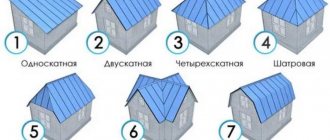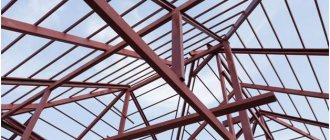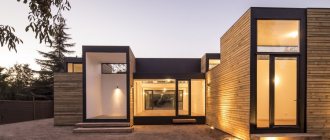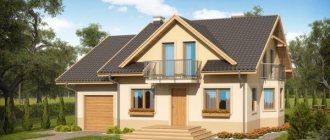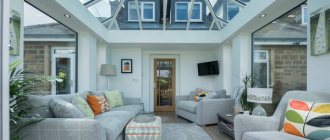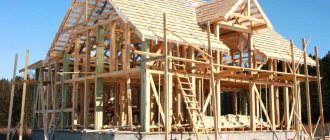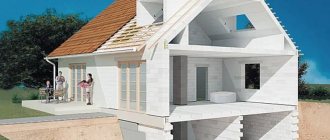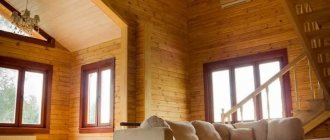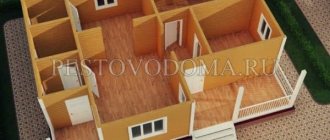Are you thinking about building a house with a pitched roof, but haven't made a final decision yet? Make no mistake: this is a good choice. Although such roofs have their own characteristics and are not always suitable, in the last decade lean-to houses around the world have experienced a real renaissance.
Architects, including eminent ones, love pitched roofs; future owners of country cottages increasingly prefer such roofs. And this is not just a matter of taste: we know at least eight reasons to choose a pitched roof for a private home. We'll tell you about them. And we’ll show you - in the article there are more than 35 photos of houses with a pitched roof. Read and see: perhaps one of our examples is exactly what you were looking for.
Main types of roofs
The main division of roofs into types is made depending on their appearance, and even the naked eye of a layman can distinguish one type of roof from another.
Flat
Modern fashion trends have made flat roofing a popular trend in private construction. Roofs of this type are soft and have a slope of up to 3°. They can be a worthy option for many reasons:
- Thanks to the minimal area, significant savings are achieved on materials, construction and installation work and construction time. The same can be said for subsequent maintenance and repairs.
- Such a roof is an additional multifunctional area. Here you can install an antenna, air conditioning system or solar panels. The roof makes it possible to equip a sports ground, a place for comfortable relaxation and sunbathing, and plant a flower garden.
The main disadvantage is the small slope angle. In areas with snowy winters, such a roof can accumulate a large mass of snow, sufficient to damage the structure. With warming, there is a high probability of leaks, but this is mainly a feature of buildings during the construction of which the construction technology was violated.
You can place a recreation area on a flat roof Source krovlyaikrysha.ru
Sloping
Pitched roofing – with sloping surfaces that allow the roof to self-clean naturally. The slope of the slopes is characterized by the angle to the horizon; it can vary from 5° to 70°.
Pitched types of roofing of private houses allow the attic space to be used for household needs and as an attic. The design of a pitched roof depends both on the architecture of the building and the material for the finishing coating, as well as on the climate.
There are various pitched roofs of houses, the varieties are grouped according to the shape and number of slopes:
- Single-pitch . Such structures rest on walls of different heights. A simple, cheap and durable option.
- Gables . They allow you to equip an attic or attic, and remove precipitation well. A practical and common option.
- Four slopes . The most durable and reliable. But the large weight of the roof requires strengthening the supporting structure.
- Tents, designer . The most unusual and expensive options.
Hip roof; ideal for a house in the form of a square or regular polygon Source happymodern.ru
Spherical
Interest in spherical structures is always high. In addition to the original appearance, they attract additional advantages:
- Streamlined shape. Allows you to avoid direct wind pressure, which is a guarantee of strength and integrity.
- Tightness. Provided with roofing material (usually galvanized steel).
- Ease of maintenance. Snow and water do not accumulate on the surface.
Roof covering
The choice of roof type is based on economic and individual (aesthetic) considerations, and also depends on the angle of the roof slope. For example, for soft roofs stability is not guaranteed at slopes greater than 45°.
Today, the most common building materials on the market are:
- ceramic tiles;
- metal tiles;
- corrugated sheeting;
- bitumen slate (ondulin);
- folded sheets;
- roll bitumen roofing.
Installation methods vary depending on the material chosen, but in almost all cases the roof is laid from the eaves to the ridge to ensure sufficient overlap and protection from precipitation. Also, the fasteners used must be made of galvanized or stainless steel materials and equipped with an elastic sealing washer.
Comparison of roofing materials - table
Optimal slope angles for roofs
Professional builders know that slope angles for roofs are selected based on the upcoming operating conditions. When determining the optimal roof slope angle, several factors are taken into account:
Natural (climatic) factors
A properly designed roof should withstand the wind and precipitation that is typical for the area.
- In areas with snowy winters, a large roof angle is set (45-60°); This way the snow melts smoothly, reducing the likelihood of icing.
- In order for the structure to withstand in areas with strong winds, the slope angle is kept to a minimum. To reduce windage, choose a range of 9-20°.
- In the southern regions, where sunny weather prevails, the best option would be a flat roof with a slope of 3-5° (for water drainage). Compared to other types of roofs, it will heat up less.
- The optimal slope angle is considered to be values from 20 to 45°.
Snow does not accumulate on a properly made roof Source nagradi.me
Type of roofing material
The minimum slope angle of the slopes depends on the choice of roofing covering.
- Slate covering, tiles. Moisture will not accumulate and leak with a minimum roof slope of 22° (for tiles) and 30° for slate.
- Roofing felt, euroroofing felt. The number of layers determines the parameter value. For a roof with 2 layers, a slope of 15° is required, for 3 layers, 5° is sufficient.
- Profiled sheet. The minimum permissible roof slope is 12°.
- Metal tiles. The minimum roof slope is limited to 14°.
- Ondulin. The minimum indicator is 6°.
- Soft tiles. Mounted with a slope of 11°.
- Membrane type roofing coverings. Set the minimum slope within 3-5°.
Do-it-yourself pitched roof: drawings and photos, exposure to wind roses
Creating a pitched roof for a bathhouse or similar structures requires choosing the correct direction of the slope. In this case, the direction of the wind rose existing in the area is taken into account. If the parameter is determined incorrectly, then during large gusts of wind the decking may be damaged. All calculations regarding weather conditions and direction are performed at the design stage.
The stability of the entire building depends on choosing the right direction.
Related article:
DIY pitched roof step by step. A separate publication provides a practical guide to installing the structure with useful tips and photos.
Structural differences of frames - popular configurations
Despite the high interest in flat roofs, the leader in popularity is still pitched roofs, which, with some stretch, can also include hip roofs. Therefore, when determining the optimal design, one primarily chooses from the following options:
Single-pitch
This design is an inclined plane that rests on external load-bearing walls of different heights. It is supplied to outbuildings (garage, veranda, barn). Its advantages are ease of installation, cost-effectiveness and ease of repair. Disadvantages: choosing such a roof excludes the construction of an attic; strong winds can tear off even a well-secured roof. But modern materials significantly increase both the beauty and strength of pitched roofs of private houses - the photo below shows one of the solutions that allows you to make a two-story house with an attic.
Modern style pitched roof Source houzz.es
Gable
Classic roof options for a private house, reliably protecting from bad weather in various climatic conditions. Such designs are easy to install and reliable in operation; You can select any material for the roof. The base consists of 2 slopes (slopes), resting on two walls of equal height.
Another name for a gable roof is gable roof (gable is the plane between the slopes).
Advantages:
- Self-cleaning from snow, low probability of leakage.
- Large selection of available materials for production.
- Possibility of arranging an attic space.
Flaws:
- Difficult installation due to the slope of the roof.
- The weakest element of the structure is the valley (the internal corner at the junction of the slopes), which experiences the maximum climatic impact.
Multi-gable roof Source vermonttimberworks.com
Combined (multi-pincer)
Multi-gable (valley) frames are among the most complex. The need for such a configuration arises if the layout of the building does not allow the use of a simpler design. The features of multi-pincer forms are:
- Complex installation of additional intersections, requiring professional knowledge and good weather.
- Additional costs of materials and time, a large amount of waste material.
- To eliminate problems with condensation, high-quality vapor and waterproofing is carried out, and high-quality ventilation is installed.
Hip and half-hip
The hip roof consists of four surfaces (slopes). The two large slopes have the shape of an isosceles trapezoid, the two side slopes are triangular (hips). In half-hip roofs (they are also called Dutch), the hip takes on a truncated appearance, which is why overhangs with a small overhang and a smaller angle of inclination are formed at the ends of the building.
These types of roofing for the roof of a private house are complex in design and installation (they require reinforcement of the rafter system), but are economical in terms of material consumption; they are justified in northern areas with strong winds.
Hip roof Source roofsrustulsa.com
See also: Catalog of companies that specialize in roof repair and design
Tent
The roof consists of slopes in the shape of isosceles triangles, converging at one point. Such a structure, which involves the construction of an attic floor, is difficult to design; A mitigating circumstance is a minimum of consumables. The aerodynamic shape of the roof helps to withstand winds.
A special class of roofs consists of round (dome) roofs, repeating the shape of a figure of rotation. Similar roofs can be seen on religious buildings; they are installed in stadiums, swimming pools, industrial buildings, verandas and winter gardens, and increasingly in private construction.
Vaulted (arched)
A vaulted (arched) roof can be designed over an attic space, a hall, a winter garden or an entrance. A supporting structure made of metal, concrete or wood is placed at the base. The coating is galvanized steel, shingles (shingles), glass, polycarbonate, transparent slate. This solution is practical and original; the coating is wind-resistant, and the use of transparent material saves energy.
Vaulted roof Source superfb.site
Geodetic
A conventional dome roof is created on the basis of a curved frame.
A geodesic dome roof allows you to get a spherical structure without the use of rafters and vertical stops. The frame is assembled from triangular elements assembled from bars. The bars are connected to each other by metal connectors; A connecting beam is installed between the rows.
To design a structure, a 3D computer modeling program is required. Compared to a pitched roof, the consumption of materials is on average one third less.
How do the different options look in the photo?
To give the building a solid and respectable look, you should choose more expensive options. For example, red tiles. You can also choose beautiful budget options; for this you should study photos of coatings on the Internet.
Shed roofs are used to create interesting and functional projects
If you have the material and some construction skills, you can create a durable and beautiful shed roof that will have good protective properties.
You can create a stylish cottage using inexpensive roofing materials
Features of attic roofs
For several centuries now, since its invention in France, mansard roofs have enjoyed constant popularity. An attic is usually called an attic space adapted (or planned) for living.
The types of roofs of private houses with an attic are pleasingly diverse. All kinds of attics are suitable for arranging attics - gable, hip, hipped, domed. There is enough space in the attic to create a living room, training room, library or winter garden. Since the attic room is located in the upper part of the building, it requires a special approach:
- Heat loss from lower living spaces causes condensation to form on the inside of the roof. The design must provide for thorough vapor and waterproofing, as well as ventilation.
- The attic space has no internal walls; it is completely in contact with the outside environment. Thermal insulation with mineral wool or polystyrene foam is relevant for the room. Natural wood is best suited for interior decoration.
Mansard roof Source julifacer.com
Reason five: more light
Natural lighting is one of the main problems of attics. Large gable windows partially help with this solution, but in most cases they do not provide enough light. Therefore, you have to install expensive skylights, which, moreover, are also a potential source of leakage.
Shed roofs do not have this problem. Even with a large slope angle, there are three walls on which standard vertical windows can be installed. With any layout, this is enough for good lighting of the premises.
Even the staircase in two-story houses with a pitched roof can be illuminated with natural light. The fact is that the landing is usually made in the area of the eaves of the building, that is, in a low place on the slope. Therefore, even if the windows for lighting it are almost at the floor level of the living premises, on the staircase itself they will be in the center of the wall and will provide a sufficient amount of light.
Cladding materials
The use of one or another type of material for roof cladding is determined primarily by the climatic characteristics of the region. Even the traditional “issue price” often gives in to common sense - no one has ever managed to save on the quality of a roof. The most popular materials are traditionally:
Roof tiles (metal, bitumen or ceramic)
- Metal shingles are a popular option valued for their durability, low price and ability to withstand impacts, which is especially valuable during loading and transportation. Metal tiles are lightweight (does not create pressure on the foundation) and are easy to attach. The disadvantage is considered to be uneconomical installation (a significant percentage goes to waste) and poor sound insulation, which becomes noticeable in any rain.
- Bituminous (flexible) tiles. This coating has high sound and heat insulation, but requires professional installation.
- Natural (ceramic) tiles. A time-tested material with the advantages of metal tiles, except one. Significant weight requires a reinforced roof.
The tiles can be laid on any roof shape Source dnolchare.blogspot.com
Slate
Slate is the most affordable material containing up to 15% asbestos. This limits its scope of application to commercial buildings. Slate has great strength during bending and impact; it is non-flammable and easy to process (cut with a grinder). The disadvantages are fragility, high hygroscopicity (over time it can become covered with moss) and a health hazard.
Glass roof
A glass roof (especially its spectacular panoramic version) attracts with many advantages. In addition to the original appearance, this design provides excellent weather protection and helps reduce energy bills. The main disadvantage is its cost, including the complexity of design and installation. In addition, in summer the room turns into a greenhouse, and in order not to look sloppy, the glass roof needs regular cleaning.
Green roof
Growing attention to environmental issues has generated interest in the green roof. Modern technical solutions developed in Scandinavian countries make it possible to realize the desire to communicate more often with nature.
Timber frame with eco-roof Source pinterest.com
During installation, layers of hydro- and thermal insulation with a waterproof membrane are laid on the roof, protecting the roof from roots. Then a drainage layer is formed and, finally, a vegetation layer (soil) on which plants can be planted.
An eco-roof serves not only as a decorative element. It maintains a stable microclimate in the house, protects against noise and reduces the load on the sewer system (by absorbing rainwater). At the same time, significant expenses on organization and time for subsequent care are inevitable.
Another option for a “green” roof Source pfpi-co.com
Reason eight: versatility
A pitched roof looks especially natural in modern architectural styles, but, unlike a flat roof, it is a universal design.
It is enough to make the rafter system open and move massive wooden beams outside the walls of the house so that the pitched roof becomes an organic part of the chalet in the now fashionable eco-style.
Another good example is a traditional Greek house with a pitched roof. Recognizable villas with white walls and blue windows, which have become the hallmark of Cyprus, have been covered with either flat or pitched roofs for more than a century.
Despite the simplicity of the silhouette, pitched roofs are combined even with rough traditional materials. In particular, with wild stone, untreated boards and logs. For example, a log house with a pitched roof made from artificially aged logs in the photo below looks quite harmonious:
This is achieved through the same technique with an open rafter system. Although the combination of thick support logs with rafters made of light calibrated boards smacks of eclecticism, the roof still looks like an organic part of the building.
And cladding lean-to houses with boards or wooden siding is generally almost a classic. This technique allows you to add depth to glass and concrete buildings so that they look like residential buildings rather than small business centers.
Sometimes wood is even combined with metal cladding:
There is a general rule: wooden elements should stand out. This means that for houses with dark cladding it is better to use beams and boards made of light wood:
And for houses with white walls - dark wood trim:
Video description
See the following video for interesting types of roofs of private houses:
And also original types of house roofs in the photo:
Symbiosis of a flat and pitched roof of a high-tech style house Source viendoraglass.com
Interesting design solution for a pitched roof Source remontbp.com
A window in the attic was once a complex technical task Source superdom.ua
The absence of a ceiling visually enlarges the room Source music4good.ru
Conical and pitched roofs on one house Source cosmictherap.com
The production of such structures should be trusted exclusively to professionals Source horodom.cx.ua
Combined multi-level roof Source weareart.ru
For such beauty to remain functional, careful calculations are required Source roofcostestimator.com
Classic solution for a two-story house Source za.pinterest.com
In such a design, it is very important to correctly make the points where the roof of the first floor meets the walls. Source houzz.com
Dome and conical
Lovers of everything unusual will certainly pay attention to the domed roof. On the one hand, it is original. It is unlikely that you will see many round roofs on your street, and their shape can be varied. On the other hand, it is functional and practical. The attic space is used rationally, and there are unlimited opportunities to fill the room with light as much as possible by installing a large number of polycarbonate windows. Standing under the dome and looking through the window at the sky is amazing.
One of the types of dome roof is conical. At its base there must be a circle that tends upward to one point. This building looks extravagant, somewhat reminiscent of ancient ethnic buildings. This solution is quite rational: precipitation does not accumulate on the roof, but immediately flows down, and the wind resistance is excellent. The use of the attic space is possible for different purposes: household needs or a living room. In any case, the usable area of the house will expand.
Rafter system
The roof truss system provides protection for the residents of the house from natural conditions. There are features of the system for each type of roof, but there are also general requirements that it must meet :
- strength and rigidity: provides stability to the roof;
- light weight: usually wood (coniferous, at least grade 1) or metal is used for the construction of rafters - if the roof is heavy;
- high quality material.
The structural elements of the rafter system are shown in the diagram below.
Source: srbu.ru
According to the type of structure, rafter systems are:
- layered: the rafters at the bottom rest on mauerlats, at the top on racks;
- hanging: supported by mauerlats on the facades of load-bearing walls;
- truss (trusses).
We will consider further the features of the system regarding each type of roof.
Preparatory work
Frontal projection of the roof drawing, plus a broken shape option Source legkovmeste.ru
To manufacture a rafter system, it is recommended to choose a base that has high strength, low dead weight, and resistance to moisture and temperature changes. Coniferous trees with a humidity of up to 20%, which do not have cracks, large knots or other defects, are best suited for this. Prepared wooden parts must be treated with fireproof mortar. To prevent fungal diseases, rotting or damage by rodents, the wood must be treated with an antiseptic substance.
Levels: attics with scope
Are you planning to make your attic more spacious than just a lived-in attic under a roof? Then decide first how many levels it will have. Yes, yes, attics are (and often are) two-story!
Why is this important to decide in advance? The point is the supports and stability of the rafter system:
- Single-level mansard roofs are the simplest in terms of design. They are not usually considered part of the home structure due to their lightness and simplicity. But at the same time, no one will stop you from making two attic rooms at once and even raising one of them onto a podium.
- Two-level mansard roofs are built as part of the house, the same as the second floor. The weight and load on the foundation is accurately calculated.
The advantages of two-level roofs are vertical walls, twice as much living space, and unusual stylish architecture. And with all this, this is still not a full-fledged second floor, and therefore the costs are not at all the same.
Have you chosen your favorite option? Then start construction, and our website will definitely help you with this!
